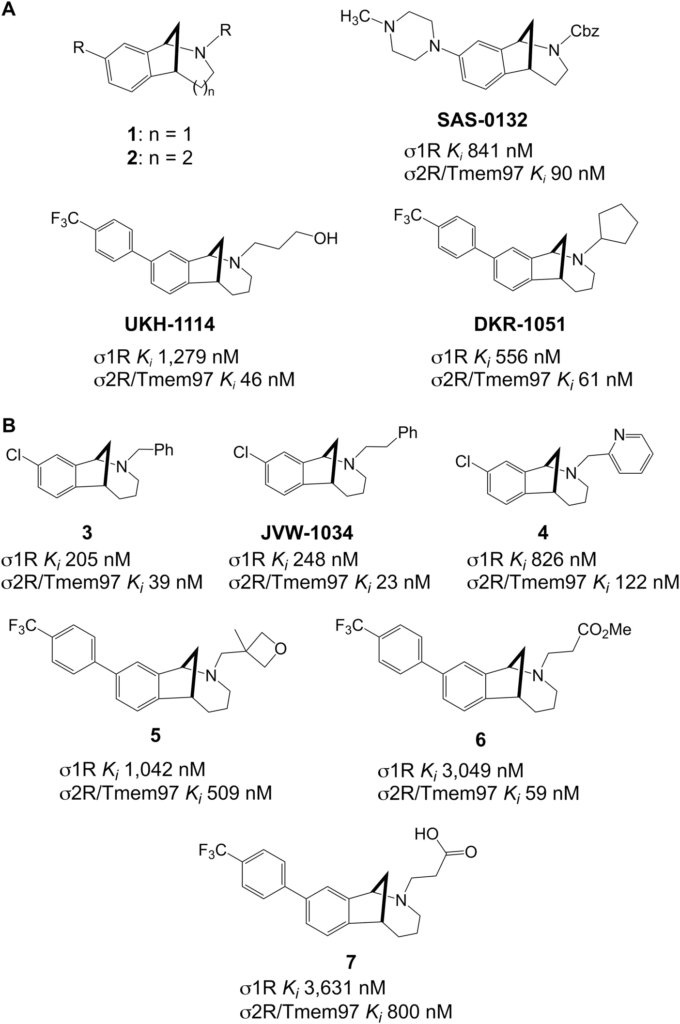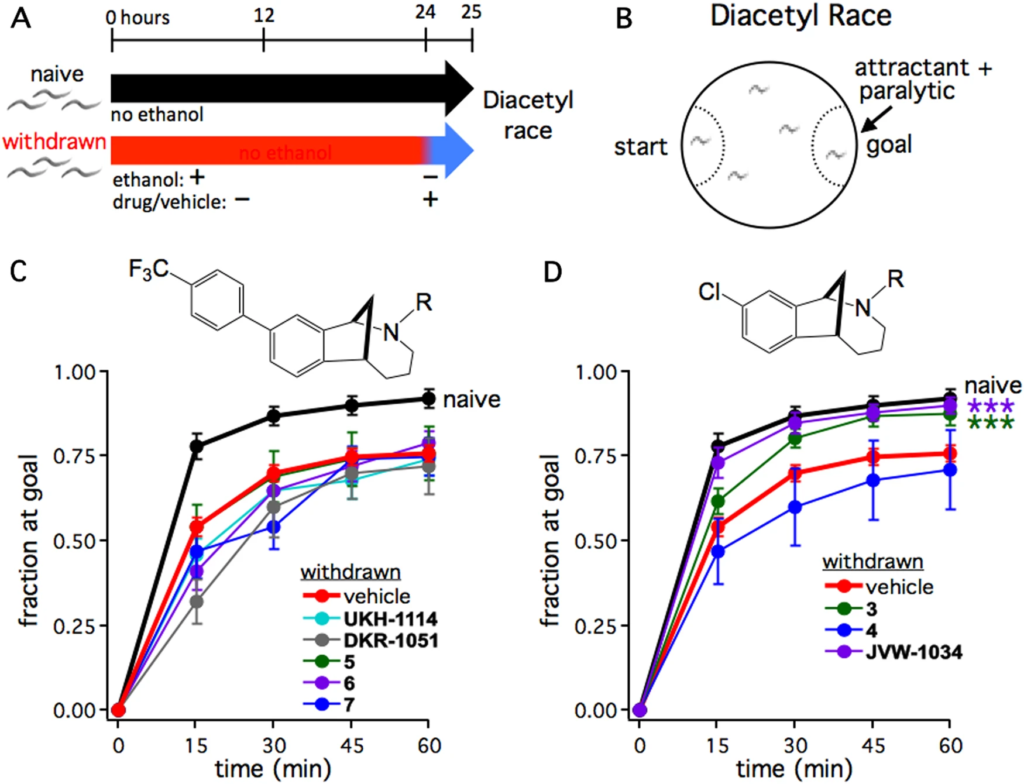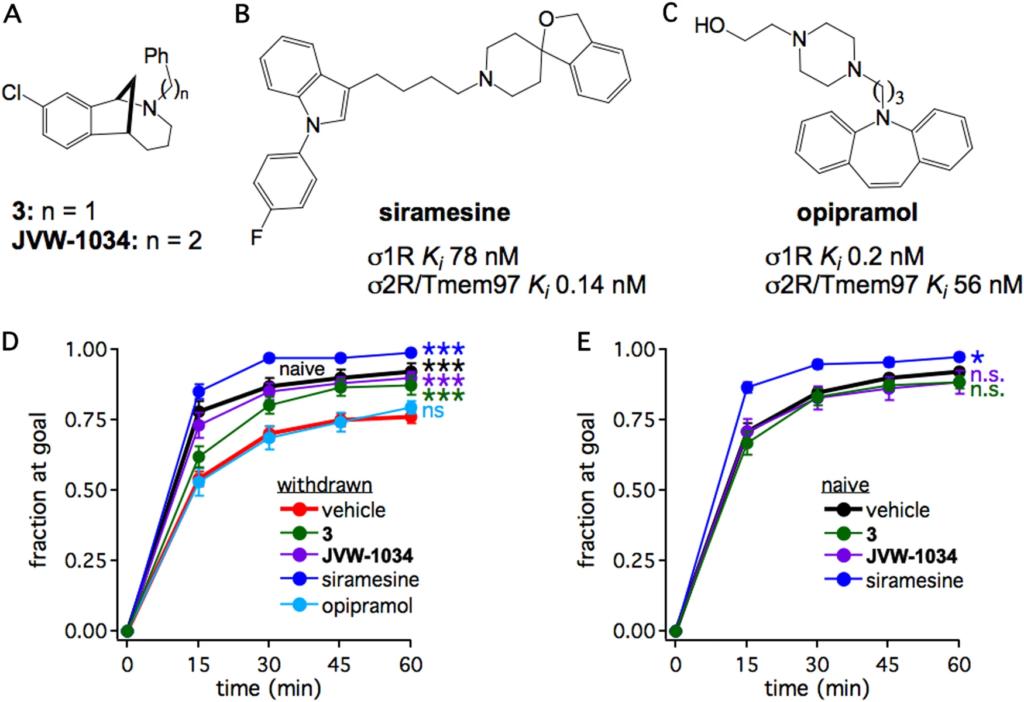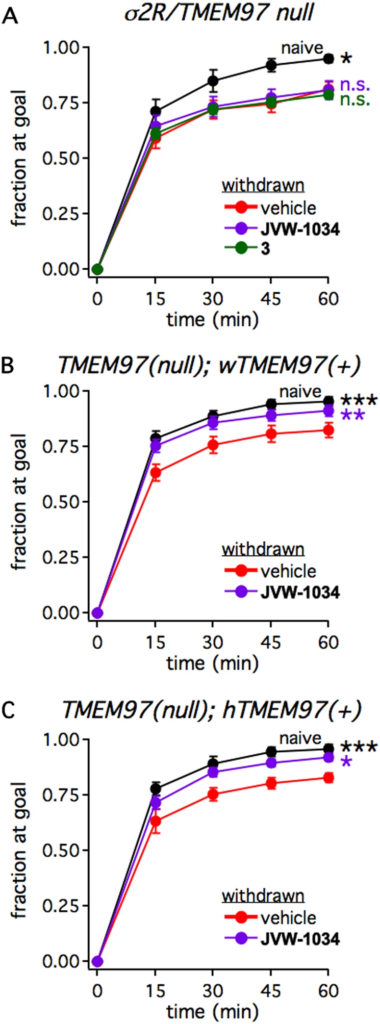Small molecule modulators of σ2R/Tmem97 reduce alcohol withdrawal-induced behaviors
By Luisa L. Scott, James J. Sahn, Antonio Ferragud, Rachel C. Yen, Praveen N. Satarasinghe, Michael D. Wood, Timothy R. Hodges, Ted Shi, Brooke A. Prakash, Kaitlyn M. Friese, Angela Shen, Valentina Sabino, Jonathan T. Pierce, and Stephen F. Martin
Excerpt from the article published in Neuropsychopharmacol 43, 1867–1875, 20 April 2018, DOI: https://doi.org/10.1038/s41386-018-0067-z
Editor’s Highlights
- Alcohol use disorder (AUD) has a lifetime prevalence as high as 29% in the US
- Siramesine, a σ2R/Tmem97 agonist, reduces behavioral impairment during withdrawal.
- Alcohol withdrawal-associated behaviors are mitigated by regulating a σ2R/TMEM97.
Abstract
Repeated cycles of intoxication and withdrawal enhance the negative reinforcing properties of alcohol and lead to neuroadaptations that underlie withdrawal symptoms driving alcohol dependence. Pharmacotherapies that target these neuroadaptations may help break the cycle of dependence. The sigma-1 receptor (σ1R) subtype has attracted interest as a possible modulator of the rewarding and reinforcing effects of alcohol. However, whether the sigma-2 receptor, recently cloned and identified as transmembrane protein 97 (σ2R/TMEM97), plays a role in alcohol-related behaviors is currently unknown. Using a Caenorhabditis elegans model, we identified two novel, selective σ2R/Tmem97 modulators that reduce alcohol withdrawal behavior via an ortholog of σ2R/TMEM97. We then show that one of these compounds blunted withdrawal-induced excessive alcohol drinking in a well-established rodent model of alcohol dependence. These discoveries provide the first evidence that σ2R/TMEM97 is involved in alcohol withdrawal behaviors and that this receptor is a potential new target for treating alcohol use disorder.
Introduction
Alcohol use disorder (AUD) has a lifetime prevalence as high as 29% in the US [1]. Unfortunately, drugs approved by the FDA to treat alcohol addiction have a high failure rate [2,3,4]. Accordingly, uncovering novel biochemical pathways underlying the disease is critical to breaking the cycle of dependence, is critical to breaking the cycle of dependence [5]. Drugs that mitigate symptoms of withdrawal may represent a promising approach because their severity is considered a major driving force for relapse [6].
Pharmacological studies have suggested that sigma receptors (σRs) may represent useful targets to counter substance abuse [7,8,9,10]. Originally mistaken as members of the opioid receptor family and as high affinity phencyclidine binding sites, two σR subtypes have been identified based on their ligand binding profiles, and more recently their genetic identity has been reported [11, 12]. The sigma-1 receptor (σ1R) was cloned over a decade ago, but the sigma-2 receptor was only recently cloned and identified as transmembrane protein 97 (σ2R/TMEM97) [11, 13]. Given that certain σ2R/Tmem97 ligands (receptor affinity defined in rat PC12 cells) appear to modulate the reinforcing, behavioral, and toxic effects of cocaine [14,15,16,17,18], we sought to test if known and novel σ2R/Tmem97 ligands might modulate alcohol-related behaviors and whether this action is actually mediated by σ2R/Tmem97.
Toward discovering novel compounds for biological screening, we developed a general platform for preparing diverse collections of substituted heterocyclic scaffolds, and we discovered a set of analogs of norbenzomorphans 1 and methanobenzazocines 2 (Fig. 1) that exhibit high affinity and selectivity for σ2R/Tmem97 [19,20,21,22]. Several of these σ2R/Tmem97 modulators show therapeutic effects in animal models of central nervous system (CNS) disorders [23, 24]. For example, the piperazine derivative SAS-0132 improves cognitive performance in a transgenic animal model of Alzheimer’s disease (AD) (Fig. 1a) [24], whereas the biaryls UKH-1114 and DKR-1051 reduce mechanical hypersensitivity in an animal model of neuropathic pain [23]. In a different study, DKR-1051 induced a rapid Ca2+transient when applied to SKH-neuroblastoma cells that was blocked by SAS-0132 [24]. The clinical efficacy of the σ2R/TMEM97 binding molecules CT-1812 and MIN-101, which are drug candidates for AD and schizophrenia, respectively, indicate that targeting σ2R/TMEM97 may be a promising approach for developing therapeutics for certain unmet medical needs in neuroscience [25, 26].

a The norbenzomorphan and methanobenzazocine scaffolds 1 and 2 and σ2R/Tmem97 modulators, SAS-0132, UKH-1114, and DKR-1051, with promising biological activities. b σ2R/Tmem97 modulators that are efficacious in animal models of alcohol withdrawal (3 and JVW-1034), and the ineffective analogs 4–7
In order to identify novel compounds that affect alcohol-related behaviors, we screened a small collection of analogs of 1 and 2 that are potent and selective σ2R/Tmem97 binding ligands [19, 20, 22]) in a model of alcohol withdrawal in the nematode Caenorhabditis elegans[27, 28]. The subtype-selective σ2R/Tmem97 ligands 3 and JVW-1034 improved behavioral impairments in worms withdrawn from chronic exposure to ethanol. The activity of these compounds was dependent upon both the worm TMEM97 ortholog that was identified during this study as well as a potential signaling partner of σ2R/Tmem97, the progesterone receptor membrane component 1 (PGRMC1). Furthermore, validating the predictive power of C. elegans, we discovered that treating ethanol-dependent rats with JVW-1034 during the ethanol withdrawal period significantly reduced voluntary ethanol intake, without affecting the low ethanol intake of non-dependent animals. The successful identification of a σ2R/Tmem97 ligand that is efficacious in a rodent model of alcohol dependence is, to our knowledge, the first evidence that σ2R/Tmem97 modulates the behavioral effects of chronic ethanol exposure and suggests that selective σ2R/Tmem97 modulators may be further developed into drug leads for treating AUD by a new mechanism of action.
…
Results
We screened our σ2R/Tmem97 binding molecules (see Fig. 1, S3 for their ability to restore behavioral function after withdrawal from chronic ethanol exposure in C. elegans. Withdrawal severity in C. elegans was assessed by behavioral performance in a chemotaxis race to the attractant diacetyl (Fig. 2a,b). Withdrawal-induced impairments in performance are reduced by low-dose ethanol [28], a fundamental trait of alcohol withdrawal in higher animals and humans [44,45,46]. Using this assay, we tested whether five σ2R/Tmem97 ligands of the biaryl series (Fig. 1; UKH-1114, DKR-1051,5–7) and three σ2R/Tmem97 ligands in the aryl chloride series (Figs. 1 and 2d; 3, JVW-1034, and 4) could reduce withdrawal-induced behavioral impairments. Vehicle-treated withdrawn worms showed significantly impaired performance in the diacetyl race compared to naive worms (p < 0.001; N = 61–77). Vehicle-treatment alone did not alter the performance of naive worms, nor did it exacerbate withdrawal-induced impairments in ethanol-treated worms (see Supplemental Table 2). The biaryl series exhibited no notable effects. In contrast, two of the three aryl chlorides, JVW-1034 and 3, significantly improved the performance of withdrawn worms (p < 0.001; N = 11–77). Notably, JVW-1034 improved performance to within the range of naive worms (Fig. 2d). Although low-dose ethanol can improve the performance of withdrawn worms, JVW-1034did not restore behavioral function by limiting ethanol clearance. Worms treated with JVW-1034 or vehicle during withdrawal both showed negligible levels of internal ethanol before behavioral testing (vehicle-treated, 0.03 ± 0.43 mM; JVW-1034-treated, −0.26 ± 0.37 mM; t-test, n.s.; N = 5–6).

Select σ2R/Tmem97 ligands improve behavioral deficits during ethanol withdrawal in C. elegans. a Worms were exposed to ethanol for 24 h prior to withdrawal (red) or kept naive (black). Analogs of UKH-1114 (c) or 3 (d) were administered during a 1-hour withdrawal period to determine the effect on behavior. b During the behavioral assay, worms migrated towards a goal containing the volatile attractant diacetyl. c, d Withdrawal-induced behavioral impairment was substantially improved by treatment with JVW-1034 and 3. Group means for AUC were compared by one-way ANOVA with Holm-Sidak post hoc comparison to the withdrawn control (vehicle-treated) group (***p < 0.001)
We then compared the behavioral effects of 3 and JVW-1034 with two commercially-available σR ligands, siramesine and opipramol, both of which have a history of clinical use [47, 48] (Fig. 3). Opipramol did not alter behavioral performance in withdrawn worms (Fig. 3d; n.s., N = 11–77), whereas siramesine improved performance in worms similar to levels for JVW-1034 and 3 (Fig. 3d; p < 0.001; N = 9–77). While JVW-1034 and 3 appear to restore naive-like behavior, withdrawn worms treated with siramesine tended to move even faster than naive worms (Fig. 3e; p = 0.07; N = 9–61). Correspondingly, siramesine sped up performance of alcohol-naive worms, while neither JVW-1034 or 3 altered the behavior of alcohol-naive worms (Fig. 3e; JVW-1034, 3: n.s.; siramesine: p < 0.05; N = 7–43). Thus, in contrast to siramesine, JVW-1034 and 3 more specifically regulated alcohol-modified behavior.

JVW-1034 and 3 improve behavioral deficits during ethanol withdrawal without altering the behavior of worms naive to ethanol. Structure and σR affinities for novel ligands (a) and two commercially available σ2R/Tmem97 ligands, siramesine (b) and opipramol (c). Unlike the commercially available ligands, treatment with selective σ2R/Tmem97 ligands 3 and JVW-1034improved behavioral performance during ethanol withdrawal (d), but did not affect performance of naive control worms (e). Group means for AUC compared by one-way ANOVA with Holm-Sidak post hoc comparison to vehicle-treated withdrawn (d) or naive (e) worms (***p < 0.001, *p < 0.05)
Compounds 3 and JVW-1034 exhibit similar high affinity and moderate within-family selectivity for σ2R/Tmem97 (Fig. 1), but they do not share off-target binding profiles for 45 other CNS proteins tested (Supplemental Table 1). This suggests that σ2R/Tmem97 binding, rather than an off-target interaction, is driving activity. We then further probed the specificity of action of these compounds in C. elegans. Though σ2R has been identified in mammals as Tmem97 [11], an ortholog of σ2R/TMEM97 had not yet been identified in C. elegans. Thus, we first identified a potential candidate, Y38H6C.16, which has 30% sequence similarity to σ2R/TMEM97, a similar predicted secondary structure, and at least partial conservation of the aspartate residues presumed to be important for ligand binding [11] (Figure S4a,b). The σ2R/TMEM97-like protein Y38H6C.16 appeared to not be required for alcohol withdrawal in C. elegans because a Y38H6C.16 null strain (allele gk910298) showed normal alcohol withdrawal (Fig. 4c; p < 0.05, N = 15). However, neither treatment with JVW-1034 nor 3improved withdrawal behavior for the Y38H6C.16(null) mutant (Fig. 4c; n.s., N = 13–15). Importantly, reintroduction of either endogenous Y38H6C.16 or the human TMEM97 gene under the endogenous promoter and 3’ UTR rescued JVW-1034 efficacy (Fig. 4d,e; p < 0.01, N = 17–18; p < 0.05, N = 16, respectively). Collectively, these findings provide functional evidence that Y38H6C.16 is an ortholog of σ2R/TMEM97 and that it is required for the observed activity of JVW-1034 and 3.

Behavioral improvement in ethanol withdrawn worms requires human or worm orthologs of σ2R/TMEM97. a A strain carrying a null mutation in the worm ortholog of σ2R/TMEM97 showed normal withdrawal behavior (naive, black vs. withdrawn, red). However, treatment with JVW-1034 or 3 failed to improve the withdrawal-induced behavioral deficit. b, c Transgenic expression of worm or human σ2R/TMEM97 rescued the ability of JVW-1034 to reduce behavioral impairment during withdrawal from ethanol exposure. Group means for AUC compared by one-way ANOVA with Holm-Sidak post hoc comparison to vehicle-treated withdrawn worms (**p < 0.01, ***p < 0.001)
There is accumulating evidence of a functional relationship between σ2R/Tmem97 and the PGRMC1. Compounds that bind to σ2R/Tmem97 can affect PGRMC1-dependent mechanisms in cultured rat neurons, human brain tissue, and in worms [24, 49]. PGRMC1 is highly conserved from yeast through humans [50], including in worms, which express the PGRMC1 ortholog, VEM-1 [51]. To determine whether JVW-1034 improves ethanol withdrawal through a PGRMC1-mediated pathway, we tested the effects of JVW-1034 on strains carrying the independent vem-1 null alleles, gk220 and ok1058. Both PGRMC1/vem-1 strains showed normal withdrawal-induced behavioral impairment (Figure S5a,b; naive vs. vehicle-treated withdrawn worms: p < 0.001, N = 22–46). Notably, this impairment was not improved by treatment with JVW-1034 during withdrawal (Figure S5a,b; n.s., N = 17–46). Transformation of the vem-1(ok1058) strain with genomic vem-1 significantly reduced withdrawal impairments relative to WT (Figure S5b,c vs. Figure 3c; Supp. Table 3; post hoc comparisons of NormAUC p < 0.001, N = 8–24). However, only one transformant strain showed significantly impaired behavior for withdrawn worms relative to naive worms (Figure S5c,d; n.s., N = 8 and p < 0.001, N = 22, respectively). In this strain, treatment with JVW-1034 significantly improved behavioral performance in withdrawn animals (Figure S5d, p < 0.05, N = 22). Thus, reduction of withdrawal symptoms in C. elegans by JVW-1034 requires PGRMC1/VEM-1.
To further explore the in vivo function of JVW-1034, we considered how overexpression of PGRMC1/VEM-1 affected withdrawal. Extrachromosomal expression of genes leads to multi-copy expression in the range of ~2–60 copies [52]. Because extrachromosomal expression of worm PGRMC1(+) on the null background reduced withdrawal impairment relative to WT, it appears that a high copy number of PGRMC1/vem-1 reduced withdrawal symptoms. To ensure that the strains had more than two copies of PGRMC1/vem-1, the two independent extrachromosomal arrays were crossed from the PGRMC1/vem-1 null background to a WT background. The subsequent strains showed less impairment after withdrawal from chronic ethanol exposure than WT (Figure S5e,f vs. Figure 2c; Supp. Table 3; post hoc comparisons of NormAUC, p < 0.001, N = 9–24). Thus, like treatment with JVW-1034, multi-copy expression of PGRMC1 reduced behavioral impairments after withdrawal. Multi-copy overexpression of PGRMC1 did not limit withdrawal behavior by altering the steady state levels or clearance of ethanol. The internal ethanol concentration for WT and PGRMC1/VEM-1-overexpressing worms was similar after a 24-h treatment with ethanol (WT, 39.7 ± 3.34; pvem-1::vem-1(+)#1, 38.2 ± 1.77; t-test, n.s.; N = 5) and again after a 1-h withdrawal period (WT, −0.88 ± 0.26; pvem-1::vem-1(+)#1, −0.98 ± 0.39; t-test, n.s.; N = 5–6). Based upon the results of the receptor binding assays and the behavioral genetic studies, we presume that the effects of JVW-1034 arise from binding to the σ2R/TMEM97 ortholog in worms, thereby activating a PGRMC1/VEM-1-dependent mechanism and leading to the observed reduction in withdrawal impairments.
We predicted that compounds that improve withdrawal behavior in C. elegans would modulate alcohol behaviors in higher order animals. To test this hypothesis, we assessed the effects of JVW-1034 on withdrawal-induced excessive ethanol drinking in rats. Rats treated with a chronic-intermittent ethanol (CIE) paradigm showed excessive ethanol self-administration compared to control rats beginning from the third session, as shown in Fig. 5a. The i.p. administration of JVW-1034 dose-dependently blocked this excessive ethanol self-administration in CIE rats, but not in Controls (Fig. 5b, Group × Dose: F(3,45) = 3.05, p < 0.05; Dose: F(3,45) = 2.92, p < 0.05; Group: F(1,15) = 63.40, p < 0.001). Post hoc analysis revealed that the middle and highest doses of JVW-1034 both significantly reduced ethanol intake compared to the vehicle condition, with the 10 mg/kg dose producing a 32.7% decrease. As shown in Fig. 5c, lever pressing for water was unaffected by JVW-1034 treatment in either group (Group × Dose: F(3,45) = 2.42, n.s; Dose: F(3,45) = 0.20, n.s.; Group: F(1,15) = 0.05, n.s.), ruling out non-specific behavioral effects of the drug.

JVW-1034 reduces voluntary ethanol self-administration in ethanol-dependent rats. a Escalation of ethanol intake in rats exposed to chronic intermittent ethanol (CIE) vs. control (Ctrl.). CIE rats were exposed to 6 weeks of intermittent ethanol vapor (14 h/day) in which no operant sessions were given, correspondent to the dotted line. Then operant sessions resumed and were given twice weekly, 6–10 h into withdrawal from vapor. Ctrl. rats were exposed to air only. BL stands for baseline (intake before CIE exposure). #p < 0.05, ##p < 0.01, ###p < 0.001 vs. Ctrl. b When administered 30 min prior to testing, JVW-1034 caused a dose-dependent reduction in voluntary ethanol self-administration in CIE, but not Ctrl. animals. *p < 0.05, ***p < 0.01, vs. Vehicle. cTreatment with JVW-1034 did not alter water intake in either Ctrl. or CIE animals
Discussion
σ1R ligands have been recognized as modulators of the rewarding and reinforcing effects of alcohol and other drugs of abuse. However, the effect of σ2R/Tmem97-subtype ligands on alcohol-related behaviors was so far unknown. Here, we used a C. elegans platform to screen for novel high affinity σ2R/Tmem97 ligands that reduced an alcohol withdrawal behavior. We discovered that JVW-1034 and 3 specifically reduced alcohol withdrawal symptoms via σ2R/TMEM97 in C. elegans. Compounds JVW-1034 and 3 each reduce behavioral deficits during withdrawal from alcohol exposure in a manner dependent on the human or worm orthologs of σ2R/TMEM97, but did not alter the behavior of worms unexposed to alcohol. JVW-1034 was then tested in a mammalian model and found to block excessive alcohol self-administration dose-dependently in chronic intermittent alcohol-treated rats, but not in controls. These findings suggest that σ2R/Tmem97-mediated pathways modulate neuroadaptation to chronic alcohol exposure and that σ2R/Tmem97 can be targeted to lessen alcohol consumption in alcohol-dependent subjects.
Our results suggest there is a conserved σ2R/TMEM97-mediated pathway that also requires PGRMC1 for modulating neuroadaptation to alcohol because JVW-1034 and 3 required both the worm orthologs of σ2R/TMEM97 and PGRMC1 to alleviate withdrawal symptoms in C. elegans. Compound activity in the strain lacking the σ2R/TMEM97 ortholog was rescued by reintroduction of either the worm or human σ2R/TMEM97 gene, indicating that σ2R/TMEM97-signaling is conserved. PGRMC1 function and signaling pathways are also well conserved in C. elegans [51, 53]). These findings provide further support for a working hypothesis that there is a functional relationship between σ2R/Tmem97 and PGRMC1 [24, 49, 54, 55]. For example, previous reports have shown that σ2R/Tmem97 ligands modulate PGRMC1-dependent mechanisms to abate neurodegeneration and toxicity from either amyloid-β or extra amyloid precursor protein [24, 49].
Although the molecular underpinnings of alcohol-related behaviors are not fully understood in any organism, many mammalian genes and molecular pathways are conserved in C. elegans[56, 57], and C. elegans has been used successfully to identify or confirm gene targets for modifying alcohol behaviors [58,59,60]. Here we show that pharmacological alleviation of a worm alcohol-withdrawal behavior predicts a reduction in voluntary ethanol consumption in alcohol-dependent rats. The successful identification of a σ2R/Tmem97 modulator that is efficacious in a rodent model of alcohol dependence underscores the utility of C. elegans for chemical screens and target validation. Moreover, the conserved σ2R/TMEM97-dependent and the PGRMC-dependent pathways described in worms likely mediates the effects of σ2R/Tmem97 ligands in higher animal models of alcohol dependence. Future work can harness the power of C. elegans genetics to determine whether genes known to modulate alcohol withdrawal behaviors in worms and mammals [27, 28, 58] are part of the pathway through which σ2R/Tmem97 modulators act.
Our findings suggest that targeting σ2R/Tmem97 with JVW-1034 reduces the rewarding properties of alcohol consumption in rats. The transition to alcohol dependence can be modeled by exposing rodents to chronic, intermittent alcohol vapors. Prolonged and intermittent periods of high blood alcohol levels that commonly occur in human alcoholics trigger long-term dysregulations of brain neurochemical systems and lead to excessive voluntary drinking and the appearance of a negative emotional state characterized by anxiety-like behavior during withdrawal [61, 62]. Using this model with high face validity, we show that JVW-1034 significantly reduces excessive alcohol drinking selectively in alcohol-dependent rats, without affecting alcohol drinking in non-dependent rats or water drinking in either group of animals. These results indicate that JVW-1034 regulates one or more of the neuroadaptations caused by chronic alcohol exposure that promote and sustain the addictive behavior. Though we cannot completely rule out polypharmacological effects of JVW-1034in these rodent experiments, our findings that JVW-1034 binds with high affinity to rat σ2R/Tmem97 and that JVW-1034 activity depends on σ2R/TMEM97 function in C. elegansstrongly suggest that σ2R/TMEM97 is mediating the effects of the drug. However, future experiments involving the use of more selective compounds, perhaps coupled with genetic manipulation of σ2R/TMEM97, will be needed to definitively probe the role of σ2R/TMEM97 in voluntary ethanol consumption in rodents.
The selective reduction in alcohol drinking in alcohol-dependent rats with JVW-1034treatment is likely due to activity in the CNS, even though these experiments involving systemic administration of the drug cannot completely rule out the contribution of peripheral effects. σ2R/Tmem97 and PGRMC1 are both expressed widely in the mammalian nervous system, including many structures of the mesolimbic reward pathway, the amygdala and frontocortical regions, which have been shown to contribute to both the positive and the negative reinforcing effects of alcohol [63,64,65,66]. Interestingly, some σ2R/Tmem97 ligands can modulate dopamine release in reward pathways [14], and glutamatergic transmission is affected by other σR ligands [16, 67]. How σ2R/Tmem97 influences neurotransmission is not yet known, but one possibility is by regulating intracellular calcium levels [68, 69]. PGRMC1 also influences intracellular calcium [70] and is detected in synaptosomes [71], potentially regulating calcium levels at the synapse.
Compared to other σR ligands that have been used in humans, JVW-1034 and 3 appear to be uniquely advantageous for modulating alcohol-related behaviors. In our C. elegansplatform, opipramol was ineffective, due to either the wrong activity at the target or off-target activities, perhaps resulting from its high σ1R affinity [13]. Siramesine, which has high specificity for σ2R/Tmem97 relative to σ1R, reduced behavioral impairment during withdrawal. However, unlike JVW-1034 or 3, siramesine altered the behavior of alcohol-naive controls. Thus, the activity of JVW-1034 and 3 appears to be more selective to chronic alcohol-induced alterations of neural and molecular pathways.
AUD is a major medical problem, so it is critical to identify new pharmacological targets to break the cycle of dependence. The present findings are thus highly significant because they are the first to show that alcohol withdrawal-associated behaviors are mitigated by regulating a σ2R/TMEM97-mediated pathway not previously associated with alcohol abuse. Moreover, these findings suggest that small molecule modulators of σ2R/TMEM97 could be developed into novel drug candidates that might provide more effective treatments for the millions of people suffering from AUD.

